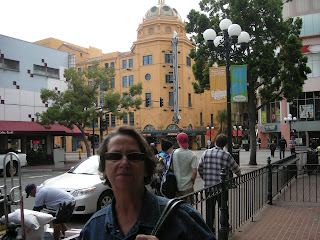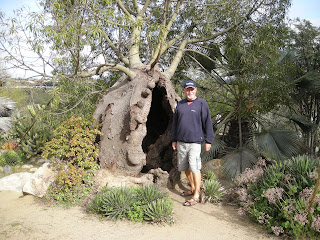
On March 16th, we visited the San Diego Area, We toured the aircraft carrier, USS Midway. We also checked out the Gaslamp District. And we toured beautiful Balboa Park. When we left San Diego, We headed for Yuma, Arizona. I-8 to Yuma had some very spectacular mountain ranges, so we took a few shots on the way.
USS Midway History





The Midway is one of the longest-serving aircraft carriers in the United States
Navy, operating from September 1945, just after World War II ended until1992 when she was decommissioned. The USS Midway is now docked in San Diego Bay and has been transformed into one of the mostvisited ship museums in the world.
It is interesting to learn how the Midway got her name. First of all, every
Navy ship in the United States has a name beginning with USS, which stands for United States Ship. The Midway was named after an important battle during World War II. This battle, which took place on Midway Island in the Pacific, represented a decisive victory for the Allied forces. That’s why the Navy chose Midway for the name of this ship.





One of the first things you will notice about the Midway when you arrive is the large 41 painted on the side of the ship. The Navy numbers its ships in order, as they are built. The very first aircraft carrier ever built in the United States was number 1, the USS Langley, built in 1922. The Midway, built in 1945, was number 41.
The newest carrier now in use is the USS George H. W. Bush, number 77.
The next thing you will notice about the Midway when you drive up close to her is
her size. She is HUGE! She is 1,001 feet long, which is about the length of 3
football fields. (The Titanic, by comparison, was just over 880 feet in length.) The
Midway is as high as a 20-story building. And, she weighs almost 70,000 tons. She
has two anchors, each weighing 20 tons, and four propellers, each one measuring 18
feet in diameter. The Midway could carry up to 80 planes. She has 3 elevators that
were used to move planes from the flight deck to inside the ship. Each of these
elevators could carry 110,000 pounds. The Midway’s crew numbered 4,500 men.
In order to keep those men well fed, the Midway’s 4 galleys (kitchens) had to serve over 13,000 meals a day.


Notice that the U.S.S. Midway is referred to by using the pronoun “she”. That is common for ALL ships. It goes back to ancient times when sailors named their ships after the women they loved and left behind when they went out to sea. Don’t be surprised if you hear a former Midway sailor say something like, “The Midway was my favorite ship.
She was the greatest. I will remember her forever.” The USS Midway sailed in every ocean in the world and fought in the Vietnam War and in the First Persian Gulf War. Over the years, she was deployed to the North Atlantic Ocean, the Caribbean Sea, the Mediterranean Sea, the Indian Ocean, and the Western Pacific Ocean. Not just a warship, she was also involved in humanitarian efforts. In 1975, the Midway was off the coast of Vietnam to help evacuate South Vietnamese people fleeing from those who had taken over their country. In 1991, when Mt. Pinatubo erupted in the Philippines, the Midway delivered emergency supplies and rescued stranded American military personnel. Some say that because of her proud career and service, the Midway is “magic”.

In 1992, after a career that lasted 47 years, the Midway was finally decommissioned. She was getting old and there were newer, more modern ships that had been built to take her place. During those 47 years, over 200,000 men had served on the Midway. She had received many awards for outstanding service. Many people wanted to honor the Midway’s fine history instead of seeing her rust away and get turned into scrap metal. So, for 12 years, a group of citizens in San Diego met with lawmakers, Navy officials, environmentalists, and city officials to make plans for bringing the Midway to San Diego and turning her into a museum. Finally, in June of 2004, the USS Midway Museum opened its doors.
Gaslamp Quarter





The Gaslamp Quarter draws a cosmopolitan populace to its streets. While the Quarter is largely devoid of sky scrapers, and instead has high rise buildings, the architecture is sophisticated and reflects a period of Victorian-style development in the city. The name sake of the Quarter, gas lamps line the streets of the Quarter on all blocks of the area. The abundance of dining venues reveals international aspects of the city that provide people with a variety of dining options reflecting global cuisine.

Shopping venues abound in the Quarter. While numerous clothing stores occupy storefront locations in the Quarter, adjacent Horton Plaza is the larger shopping center accommodating numerous stores.
The Gaslamp Quarter is the historic heart of San Diego, California. It is a 16½ block historical neighborhood in Downtown San Diego and is the center of downtown night life. The Quarter is home to many events and festivals, including Mardi Gras in the Gaslamp, Street Scene Music Festival, Taste of Gaslamp and ShamROCK, a St. Patrick's Day event. PETCO Park, home of the San Diego Padres is located one block away in downtown San Diego's East Village.
The area is listed as a historic district on the National Register of Historic Places as Gaslamp Quarter Historic District. Its main period of development began in 1867, when Alonzo Horton bought the land in hopes of creating a new city center closer to the bay, and chose 5th Avenue as its main street. After a period of urban decay, the neighborhood underwent urban renewal in the 1980s and 1990s, and is today an energetic business and entertainment district.
The Gaslamp Quarter extends from Broadway to Harbor Drive, and from 4th to 6th Avenue, covering 16½ blocks. It includes 94 historic buildings, most of which were constructed in the Victorian Era, and are still in use with active tenants including restaurants, shops and nightclubs.
When development of the area began in the 1860s, the area currently known as the Gaslamp Quarter was known as New Town, in contrast to Old Town, which was the original Spanish colonial settlement of San Diego. The name "Gaslamp Quarter" is a reference to the gas lamps that were common in San Diego in the late 19th and early 20th centuries. Four new gaslamps have been installed at the intersection of Market Street and 5th Avenue to evoke that time.
The Gaslamp Quarter features a pedestrian scramble at the intersection of 5th Avenue and Market Street.
Balboa Park




Balboa Park is a 1,200-acre (490 ha) urban cultural park in San Diego, California. The park is named after the Spanish maritime explorer Vasco Núñez de Balboa. It was the location of the 1915 Panama–California Exposition and 1935 California Pacific International Exposition which each created architectural landmarks for the park.
The park's site was placed in reserve in 1835, and so is one of the oldest sites in the United States dedicated to public recreational use. In addition to open space areas, natural vegetation green belts, gardens and walking paths, it contains a variety of cultural attractions including many museums, several theaters, and the world famous San Diego Zoo. There are also many recreational facilities and several gift shops and restaurants.





Balboa Park, and the historic Exposition buildings, were declared a National Historic Landmark and National Historic Landmark District in 1977, and placed on the National Register of Historic Places. Balboa Park is managed and maintained by the stewardship of the Parks and Recreation Department of the City of San Diego.



Although the vortex idea is more of a metaphysical concept than a scientific fact, there is no doubt that countless visitors to Sedona are convinced there are unique energies in the area that stimulate creativity and spiritual growth. Tour guides who take groups of visitors to the vortexes say Sedona has a long history as a sacred place for healing and purification, as Native Americans have been coming to the region for thousands of years to perform spiritual ceremonies.
ReplyDeleteilchi lee